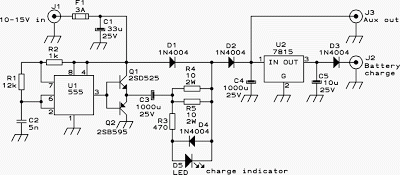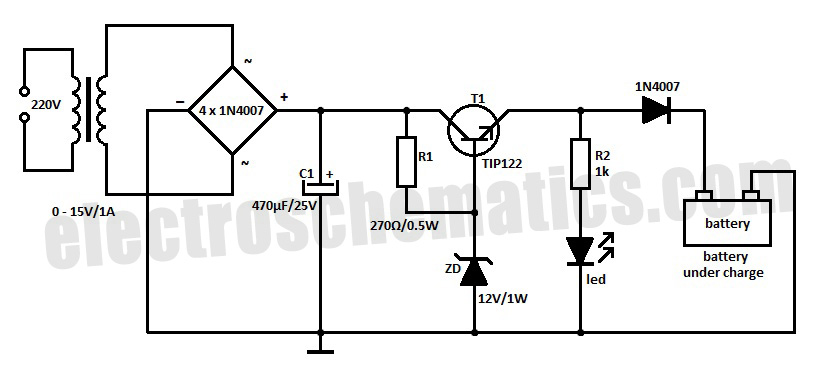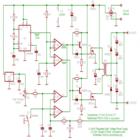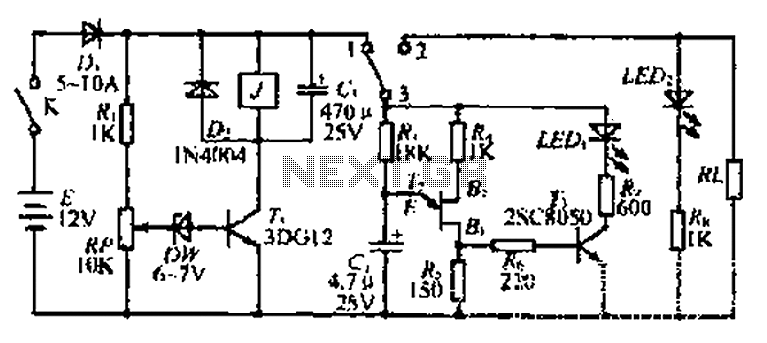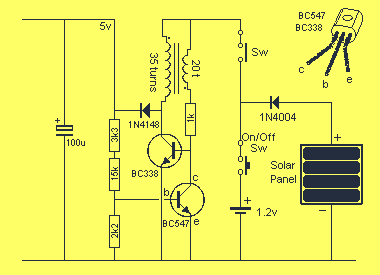
Regulated Charge Pump
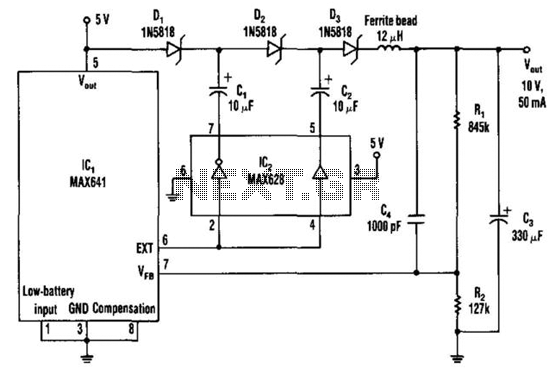
The DC-DC converter replaces a voltage tripler for the external inductor and diode typically associated with the switching regulator, IC1. Inverting and non-inverting amplifiers in the MOSFET driver (IC2) activate a diode-capacitor tripling network (D1 through D3, C1 through C3). A 50-kHz oscillator within IC1 generates the EXT signal (pin 6), and IC2 converts this signal into drive signals that are 180° out of phase for the tripler. The resulting charge-discharge action in the capacitors recharges C3 to approximately 10 V every 20 cycles. A ferrite bead limits output ripple to about 20 mVpp for a 50 mA load. The conversion efficiency is approximately 70% for the 5 V input and 10 V output configuration.
The described DC-DC converter circuit operates by utilizing a voltage tripler configuration that eliminates the need for an external inductor and diode, which are commonly found in traditional switching regulators. The core of this design involves an integrated circuit, IC1, which features a built-in 50 kHz oscillator responsible for generating the EXT signal at pin 6. This signal serves as the primary control input for the MOSFET driver, IC2.
IC2 contains both inverting and non-inverting amplifiers that facilitate the generation of drive signals that are 180° out of phase. This phase difference is crucial for the effective operation of the diode-capacitor tripling network, which consists of diodes D1, D2, and D3, along with capacitors C1, C2, and C3. The tripling network effectively multiplies the input voltage, allowing the capacitors to charge and discharge in a coordinated manner, ultimately recharging capacitor C3 to a target voltage of approximately 10 V every 20 cycles.
To ensure a stable output voltage with minimal fluctuations, a ferrite bead is employed to limit output ripple to about 20 mVpp when a load of 50 mA is applied. This feature is essential for applications requiring a clean and stable voltage supply. The overall conversion efficiency of the circuit is around 70%, which is a practical performance level for a configuration that converts a 5 V input to a 10 V output. This efficiency is a critical factor in battery-powered applications where energy conservation is paramount.
In summary, this DC-DC converter design effectively utilizes a voltage tripler configuration to achieve a higher output voltage while maintaining efficiency and minimizing output ripple, making it suitable for various electronic applications. The dc-dc converter substitutes a voltage tripler in place of the external inductor and the diode that"s typically as sociated with the switching regulator, IC1. Inverting and noninverting amplifiers in the MOS-FET-driver (IC2) activate a diode-capacitor tripling network (D1 through D3, CI through C3). A 50-kHz oscillator residing within IC1 produces the EXT signal (pin 6), IC2 converts this signal into drive signals (180° out of phase) for the tripler.
The resulting charge-discharge action in the capacitors recharges C3 toward 10 V every 20 The ferrite bead limits output ripple to about 20-mVpp for a 50-mA load. Conversion efficiency is about 70% for the 5-V input, 10-V output configuration.
The described DC-DC converter circuit operates by utilizing a voltage tripler configuration that eliminates the need for an external inductor and diode, which are commonly found in traditional switching regulators. The core of this design involves an integrated circuit, IC1, which features a built-in 50 kHz oscillator responsible for generating the EXT signal at pin 6. This signal serves as the primary control input for the MOSFET driver, IC2.
IC2 contains both inverting and non-inverting amplifiers that facilitate the generation of drive signals that are 180° out of phase. This phase difference is crucial for the effective operation of the diode-capacitor tripling network, which consists of diodes D1, D2, and D3, along with capacitors C1, C2, and C3. The tripling network effectively multiplies the input voltage, allowing the capacitors to charge and discharge in a coordinated manner, ultimately recharging capacitor C3 to a target voltage of approximately 10 V every 20 cycles.
To ensure a stable output voltage with minimal fluctuations, a ferrite bead is employed to limit output ripple to about 20 mVpp when a load of 50 mA is applied. This feature is essential for applications requiring a clean and stable voltage supply. The overall conversion efficiency of the circuit is around 70%, which is a practical performance level for a configuration that converts a 5 V input to a 10 V output. This efficiency is a critical factor in battery-powered applications where energy conservation is paramount.
In summary, this DC-DC converter design effectively utilizes a voltage tripler configuration to achieve a higher output voltage while maintaining efficiency and minimizing output ripple, making it suitable for various electronic applications. The dc-dc converter substitutes a voltage tripler in place of the external inductor and the diode that"s typically as sociated with the switching regulator, IC1. Inverting and noninverting amplifiers in the MOS-FET-driver (IC2) activate a diode-capacitor tripling network (D1 through D3, CI through C3). A 50-kHz oscillator residing within IC1 produces the EXT signal (pin 6), IC2 converts this signal into drive signals (180° out of phase) for the tripler.
The resulting charge-discharge action in the capacitors recharges C3 toward 10 V every 20 The ferrite bead limits output ripple to about 20-mVpp for a 50-mA load. Conversion efficiency is about 70% for the 5-V input, 10-V output configuration.

